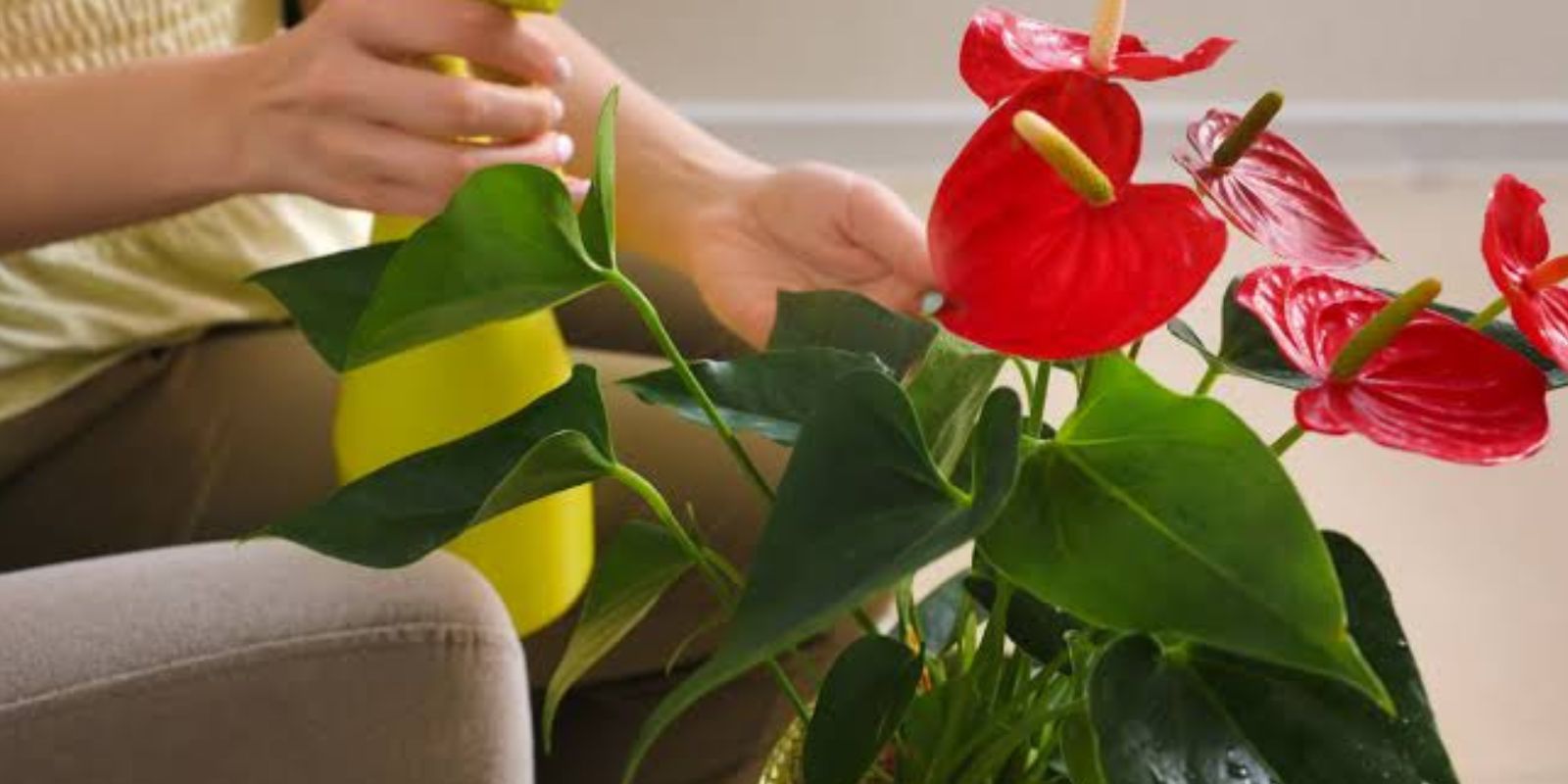Anthuriums, commonly known as flamingo flowers or painter’s palette, are among the most striking indoor plants. With their glossy, heart-shaped leaves and vibrant blooms, they can brighten any space. Native to the tropical regions of Central and South America, these plants are both exotic and hardy, making them a favorite for indoor gardeners. However, like all plants, they require specific care to flourish. This article provides a detailed guide to ensure your Anthurium thrives for years to come.
Understanding Anthuriums: What Makes Them Unique?
Anthuriums belong to the Araceae family, and their distinctive flowers are actually modified leaves called spathes. These spathes come in various colors, including red, pink, white, and even green. The true flowers are tiny and found on the central spike called the spadix. Anthuriums are perennial plants, meaning they can bloom year-round with proper care.
While their beauty is captivating, it’s essential to remember that Anthuriums are toxic to pets and humans if ingested. Always handle them with care and keep them out of reach of curious pets or children.
1. Light Requirements
Anthuriums thrive in bright, indirect sunlight. Direct sunlight can scorch their delicate leaves, leading to unsightly burn marks.
- Ideal Placement: Position your Anthurium near an east- or north-facing window where it gets ample light without direct exposure.
- Low-Light Tolerance: While they can survive in low light, they won’t bloom as profusely. Consider supplementing with a grow light if natural light is insufficient.
2. Watering: Striking the Right Balance
Watering Anthuriums correctly is crucial for their health. Overwatering can lead to root rot, while underwatering may cause the leaves to dry and curl.
- When to Water: Check the top inch of the soil. If it feels dry, it’s time to water. Typically, watering once a week is sufficient, but frequency may vary based on the season and environment.
- Method: Water thoroughly until it drains from the bottom of the pot. Empty the saucer to avoid waterlogging.
- Signs of Trouble:
- Yellowing leaves indicate overwatering.
- Browning leaf tips suggest underwatering.
3. Humidity: A Tropical Essential
Being tropical plants, Anthuriums thrive in humid conditions. Indoor environments, especially during winter, can be too dry for their liking.
- Humidity Levels: Aim for 60–80% humidity.
- Tips to Increase Humidity:
- Use a humidifier near your plant.
- Mist the leaves regularly with distilled water.
- Place a tray of water with pebbles under the pot (ensure the pot isn’t sitting in water).
4. Temperature Needs
Anthuriums prefer warm temperatures between 65–80°F (18–27°C). They are sensitive to sudden temperature changes and cold drafts.
- Keep Them Warm: Avoid placing your Anthurium near air conditioners, heaters, or drafty windows.
- Winter Care: If the temperature drops below 60°F (15°C), move the plant to a warmer spot to prevent stress.
5. Choosing the Right Soil and Pot
The right soil and pot can make all the difference for your Anthurium’s growth.
- Soil Type: Use a well-draining potting mix with a combination of peat moss, perlite, and orchid bark. This mimics their natural epiphytic environment.
- Pot Choice: Select a pot with drainage holes to prevent waterlogging. Terracotta pots are excellent as they allow excess moisture to evaporate.
6. Fertilizing for Healthy Growth
Anthuriums are not heavy feeders but benefit from occasional fertilization during the growing season (spring and summer).
- Fertilizer Type: Use a balanced, water-soluble fertilizer diluted to half strength.
- Frequency: Feed every 6–8 weeks. Avoid fertilizing in fall and winter when the plant’s growth slows.
- Signs of Overfertilization: Brown leaf tips or a buildup of white residue on the soil surface.
7. Pruning and Maintenance
Regular pruning helps keep your Anthurium looking its best and encourages healthy growth.
- Remove Dead Leaves: Trim yellow or brown leaves to redirect the plant’s energy.
- Spent Flowers: Cut off faded blooms at the base to stimulate new growth.
- Clean Leaves: Wipe the leaves with a damp cloth to remove dust and enhance photosynthesis.
8. Repotting: Refreshing the Plant’s Environment
Anthuriums typically need repotting every 2–3 years. Repotting provides fresh soil and more space for root growth.
- When to Repot: Look for signs like roots growing out of the drainage holes or soil that dries out too quickly.
- How to Repot:
- Gently remove the plant from its current pot.
- Shake off old soil and inspect the roots for damage.
- Replant in fresh potting mix and water thoroughly.
9. Propagation: Expanding Your Anthurium Collection
Anthuriums can be propagated through division. This is an excellent way to grow more plants or share them with friends.
- Steps:
- Gently remove the plant from its pot.
- Separate the root clumps, ensuring each has a healthy stem and roots.
- Plant each division in its own pot with fresh soil.
10. Common Problems and Solutions
Despite their resilience, Anthuriums can encounter issues. Here’s how to address them:
- Pest Infestation:
- Watch for aphids, spider mites, and mealybugs. Treat with insecticidal soap or neem oil.
- Leaf Discoloration:
- Yellow Leaves: Overwatering or low light.
- Brown Tips: Underwatering or low humidity.
- No Blooms:
- Ensure the plant is getting enough light and is fertilized during the growing season.
Bonus Tip: How to Make Anthuriums Rebloom
Encourage your Anthurium to produce more blooms by following these tips:
- Increase light exposure while avoiding direct sunlight.
- Feed regularly with a phosphorus-rich fertilizer during the growing season.
- Maintain consistent humidity and temperature levels.
Conclusion
Caring for an Anthurium can be a deeply rewarding experience. With its striking appearance and long-lasting blooms, this plant can transform any indoor space into a tropical haven. By providing the right light, water, and nutrients, you can ensure your Anthurium thrives for years, rewarding you with vibrant foliage and beautiful flowers.
💬 What’s your secret to keeping Anthuriums healthy? Share your tips and tricks in the comments below!

